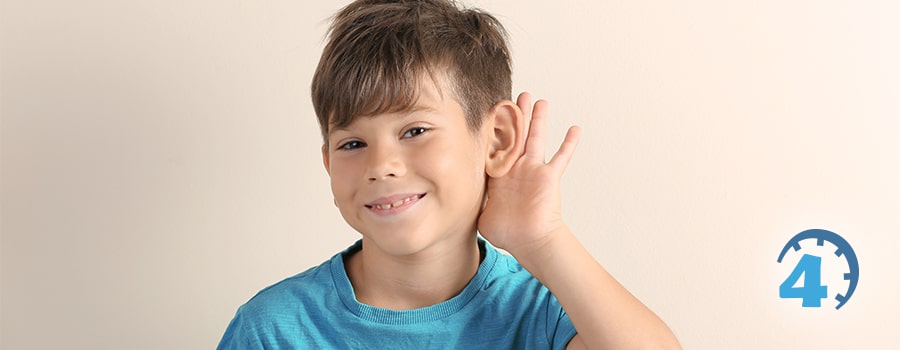Imagine a world where the symphony of sounds around you becomes a confusing jumble, a cacophony of whispers and shouts. This is the reality for many children and adults struggling with auditory processing disorder (APD), a condition that makes it difficult to understand and interpret sounds. But fear not, because speech therapy can help! By setting specific auditory processing goals, speech therapists empower individuals to navigate the world of sound with confidence and clarity.

Image: www.pinterest.com
Auditory processing, the brain’s ability to take in, interpret, and make sense of sound, is crucial for communication, learning, and overall development. Imagine your brain as a conductor leading an orchestra of sound, each instrument representing a different component of auditory processing. When one instrument falters, the entire melody is disrupted. Speech therapy, in this analogy, works to fine-tune the orchestration, helping each instrument play in harmony.
Understanding Auditory Processing Goals
Auditory processing goals in speech therapy are tailored to the individual’s specific needs and challenges. They address the intricate components of auditory processing, helping individuals develop skills to:
- Sound Localization: Determining the direction and location of a sound source. Imagine pinpointing the source of a bird’s chirping amidst a bustling city park.
- Auditory Discrimination: Distinguishing between different sounds, like recognizing the sound of a ringing phone in the midst of a conversation. This ability is essential for understanding spoken language, recognizing musical notes, and even identifying bird calls.
- Auditory Memory: Remembering and recalling sounds, such as remembering the instructions given by a teacher or the lyrics of a song.
- Auditory Figure-Ground: Focusing on a specific sound while ignoring other background noise. This ability is crucial for understanding speech in noisy environments, such as a crowded restaurant or a busy street.
- Temporal Processing: Understanding the duration and timing of sounds, essential for recognizing the rhythm of music, understanding speech patterns, and perceiving the subtle nuances of language.
A Tailor-Made Approach
Speech therapists use a variety of techniques to achieve auditory processing goals, including:
- Auditory Training Exercises: These exercises focus on improving specific skills, such as sound discrimination, localization, and memory. They might involve listening to different sounds and determining their source, identifying specific words in a sentence, or repeating a sequence of spoken words.
- Environmental Modifications: Creating a quiet, sound-controlled environment can help individuals focus on auditory information. This may involve using noise-canceling headphones, adjusting seating arrangements, or reducing background noise.
- Assistive Technology: Devices like personal FM systems can enhance sound clarity, allowing individuals to more easily hear and process auditory information. These systems transmit sound directly to the listener’s ear, amplifying the desired sound and reducing background noise.
- Cognitive Strategies: Teaching individuals strategies to improve attention, focus, and memory while processing auditory information. This might include techniques like chunking information, using visual aids, or practicing mindfulness.
- Multisensory Approaches: Incorporating visual and tactile elements can enhance auditory processing by engaging multiple senses. For example, a speech therapist might use visual cues, physical movements, or objects to represent sound concepts.
Navigating the Journey with Speech Therapy
Speech therapy for auditory processing isn’t a quick fix but rather a gradual journey. Consistency, patience, and a supportive environment are essential for success. Here are some tips to make the most of this journey:
- Partner with Your Therapist: Openly communicate with your speech therapist about your child’s strengths, challenges, and your expectations for therapy.
- Practice, Practice, Practice: Regular practice outside of therapy sessions is crucial for strengthening newly acquired skills. Incorporate fun activities that involve listening, such as playing music, listening to audiobooks, or engaging in interactive storytelling.
- Create a Supportive Environment: Minimize distractions at home, provide a quiet space for studying or completing homework, and actively listen when your child is communicating with you. This creates a positive environment that fosters learning and reinforces the skills learned in therapy.

Image: www.time4learning.com
Auditory Processing Goals For Speech Therapy
Empowering Individuals, Transforming Lives
Auditory processing goals in speech therapy are not just about addressing challenges; they are about empowering individuals to reach their full potential. By enhancing auditory processing skills, individuals can enjoy a richer and more fulfilling life. They can participate more confidently in conversations, excel in academic settings, and navigate a world that often requires keen auditory awareness.
If you or your loved one is struggling with auditory processing, remember, you’re not alone. Seek the guidance of a qualified speech therapist, engage in therapy with commitment, and celebrate each step of progress. The journey to unlocking the power of sound is a worthwhile endeavor that can lead to a life filled with clarity, connection, and opportunity.






